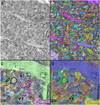The big data challenges of connectomics
- PMID: 25349911
- PMCID: PMC4412267
- DOI: 10.1038/nn.3837
The big data challenges of connectomics
Abstract
The structure of the nervous system is extraordinarily complicated because individual neurons are interconnected to hundreds or even thousands of other cells in networks that can extend over large volumes. Mapping such networks at the level of synaptic connections, a field called connectomics, began in the 1970s with a the study of the small nervous system of a worm and has recently garnered general interest thanks to technical and computational advances that automate the collection of electron-microscopy data and offer the possibility of mapping even large mammalian brains. However, modern connectomics produces 'big data', unprecedented quantities of digital information at unprecedented rates, and will require, as with genomics at the time, breakthrough algorithmic and computational solutions. Here we describe some of the key difficulties that may arise and provide suggestions for managing them.
Figures


References
-
- Helmstaedter M. Cellular-resolution connectomics: challenges of dense neural circuit reconstruction. Nat. Methods. 2013;10:501–507. - PubMed
-
- Lichtman JW, Denk W. The big and the small: challenges of imaging the brain’s circuits. Science. 2011;334:618–623. - PubMed
-
- Hell SW. Far-field optical nanoscopy. Science. 2007;316:1153–1158. - PubMed
-
- Livet J, et al. Transgenic strategies for combinatorial expression of fluorescent proteins in the nervous system. Nature. 2007;450:56–62. - PubMed
-
- Cai D, Cohen KB, Luo T, Lichtman JW, Sanes JR. Improved tools for the Brainbow toolbox. Nat. Methods. 2013;10:540–547. Epub 2013 May 5. - PubMed
Publication types
MeSH terms
Grants and funding
LinkOut - more resources
Full Text Sources
Other Literature Sources

